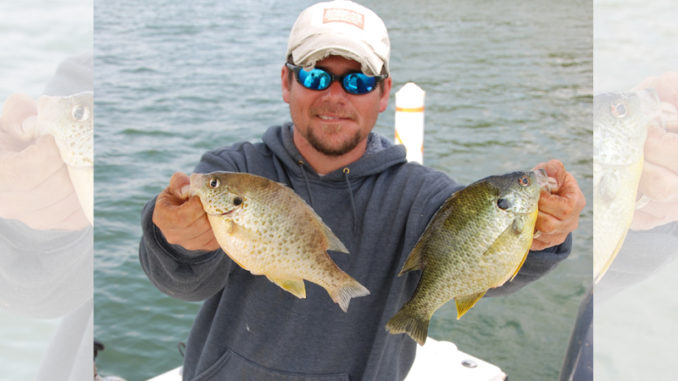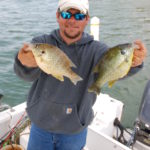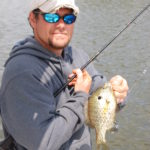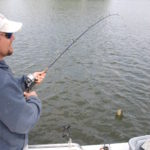
Shellcrackers are tops among panfish on Lake Murray
What do striped bass and shellcrackers have in common? At first blush, very little, until you hear guide Brad Taylor talk about Lake Murray.
“If you’ve ever been cut-bait fishing for stripers on Lake Murray, then you already know how to fish for shellcrackers,” said Taylor.
Sitting in one of the captain’s chairs in Taylor’s boat, watching a handful of light-action rods pointing in all directions, you get the feeling that Taylor is spot-on in his assessment.
To punctuate his statement, one of the rods came to life, bowing over to the weight of a lively fish. Taylor quickly stepped to the back of the boat and began reeling. The fish made two hard-charging runs before he slid the net under it and added it to the livewell with the others.
Most of the time Taylor slides his boat into Lake Murray, he’s targeting striped bass. That is, when he’s not crappie-fishing in the spring, bowfishing in the summer and hunting alligators during the fall. But he’s also one of only a few guides on Lake Murray who advertises for bream-fishing trips.
Shellcrackers are bunching up, getting ready for the spring spawn
Of course, the term “bream” means different things to different people. Most anglers think of bluegills, which are also abundant in Lake Murray. Taylor thinks of shellcrackers, officially, redear sunfish, if you prefer its proper name.
“I love to go after shellcrackers this time of year,” Taylor said. “Shellcrackers are a fairly cold-water fish. The last of February through March, they are still on somewhat of a winter pattern. The females will have eggs in them. So it’s a good time to find them bunched up before they start getting ready for the spawn.”
For shellcracker fishing, Taylor favors what he calls “dead bays” — coves off of the main lake or major creeks that don’t have a creek with flowing water entering its rear section. Long rocky points also hold numbers of prespawn shellcrackers.
“If you can catch a string of warm days, shellcrackers will move into the backs of those dead bays or up on top of a long point,” he said. “You’ll find them as shallow as two to four feet. On most days, the average depth this time of year is about 10 to 12 feet deep.”
Favorite areas for finding shellcrackers on Lake Murray include Hollow Creek, Bear Creek, Crystal Lake and many of the shallow rocky bays found in the vicinity of Dreher Island.
Look for water that warms quickly by the sun
“Short, rocky points and shoals are good spots to try as the fish move up and back on a daily basis,” he said. “Any structure you see on a long point like stumps, weeds, rocks or brush will help warm that point up when the sun hits it. So look for the fish to be a little shallower.”
Trying to pattern shellcrackers is a bit of a mystery. Ron Ahle, a fisheries biologist for the S.C. Department of Natural Resources said the state hasn’t done a lot of surveys on shellcrackers on Lake Murray. He said they are opportunistic feeders that eat their fair share of clams and mussels, making any location that displays a lot of mussel-shell debris a likely hotspot. The fish will just as readily eat small crustaceans like crayfish and aquatic insects. The common thread is that these scrappy panfish make their living on the lake bottom. So fishing anywhere else in the water column is a waste of time.
“You need to be on the bottom to catch shellcrackers,” said Ahle. “Most panfish like bluegills and crappie feed upward, making a mid-water presentation more preferable. Shellcrackers feed down. They have sharp eyesight and are able to see any subtle movement on the bottom through Murray’s clear water.”
Shellcrackers have a leg up on bluegills at Lake Murray
Ahle had another surprising observation comparing shellcrackers to other species of panfish.
“Shellcrackers seem to be more suited to Lake Murray than bluegill,” he said. “With all the rocky habitat, the environment is just more conducive to them.”
Ahle goes on to point out that this has not always been the case. Between 2002 and 2007, Murray’s frequent low water levels — mostly due to dam remediation, power generation schedules, and drought conditions — caused a drop in the available spawning habitat. Since that time, more-stable water levels have allowed shellcrackers access to better nursery habitat. This allows better recruitment of the species.
Ahle had a word of advice for anglers who do find concentrations of shellcrackers.
“Don’t wait,” he said. “Shellcrackers don’t stay on the beds more than two or three weeks. If you locate a concentration of fish and come back to them later, they may be gone.”
Look past beds for bigger fish
Ahle suggested anglers who were after big ’crackers might do better to avoid fishing a spawning bed altogether. He said they should concentrate on the larger female fish holding beyond it.
Shellcraker males guard the nest. The females hang back on the next drop, like crappie,” he said. “I suspect most of them spawn at night, since you rarely see both a male and a female on the nest together. I’d suggest positioning the boat somewhere between the bed and the next drop-off, where you can reach both.”
Taylor agrees. For his cut-bait style of fishing, he prefers to anchor the boat fore and aft so it won’t swing while he has lines cast out in positions around the clock. Toward the end of March and into April, he might be able to accomplish this by beaching the nose of the boat on a point.
“For bait, I use whole night crawlers,” he said. “I want to make sure I can reach a variety of depths. That’s because these fish move in and move up and down on that point.”
Despite the lighter tackle and worms for bait, Taylor prefers the “striped-bass approach” to shellcrackers over the “bluegill approach.”
Shellcrackers aren’t easily spooked
“Shellcrackers are more dialed-in on the bottom than bluegills, so I rarely catch shellcrackers using crickets,” he said. “The other thing about bluegills is that you will almost always find bluegills using a shellcracker bed in May after the shellcrackers have left. But I rarely find shellcrackers using an old bream bed.”
Toward the end of March, Taylor will seek shellcracker beds in earnest, looking for actively prespawn and spawning fish. He suggests that scouting for beds is a lot different — and easier — than scouting for bream beds.
“I’ll put out the trolling motor and move along while standing on the bow, looking down in the water,” he said. “Shellcrackers are not boat-shy at all — they’re probably the only fish I guide for that aren’t. If I troll up on a bluegill bed, I’ll mark it and have to come back several hours later to fish it. With shellcrackers, once you find them, you can just pull up and start fishing.”
DESTINATION INFORMATION
HOW TO GET THERE — Several public boat ramps are close to the mid-lake/Dreher Island area, the majority of which are located in Lexington County. For a complete listing, see the SCDNR website, www.dnr.sc.gov/pubs/boatfacilities.pdf
TACTICS/TECHNIQUES — Guide Brad Taylor suggests using a shotgun, cut-bait style approach to shellcracker fishing. He anchors his boat on the side of a long point and fan-casts multiple rods in all directions. He prefers whole nightcrawlers, using a down-sized Carolina rig with a No. 2 Aberdeen hook. Make sure to cover a variety of depths, as shellcrackers tend to move up and down on a point.
FISHING INFO/GUIDES — Brad Taylor, Taylor Outdoors, 803-331-1354, http://www.tayloroutdoors.com/. See also GUIDES & CHARTERS in Classifieds.
ACCOMMODATIONS — RiverWinds Landing, 221 Highway 391, Prosperity, 803.364.0036; Holiday Inn Express Hotel & Suites, 131 Inn Keeper Dr., Lexington, 803-808-0800; Hampton Inn Lexington, 601 Columbia Ave., Lexington, 803-356-8300; Lake Murray Country Visitor’s Bureau, 866-SCJEWEL, http://www.lakemurraycountry.com/
MAPS — Navionics Electronic Charts, 800-848-5896, http://www.navionics.com/; Fishing Hot Spots, 800-ALLMAPS, http://www.fishinghotspots.com/; Delorme South Carolina Atlas & Gazetteer, 1 (800) 561-5105 http://www.delorme.com/.





Be the first to comment